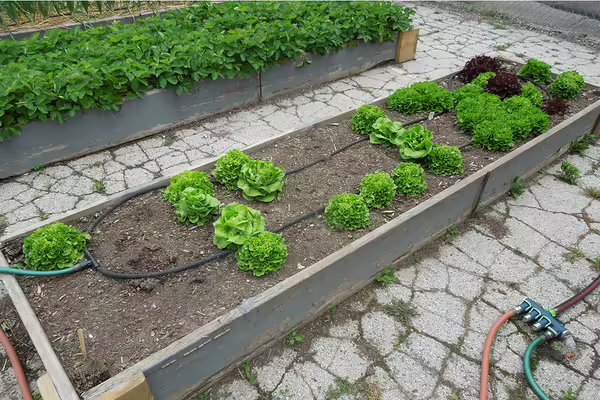
URBANA, Ill. — Whether for convenience or accessibility, raised beds are a popular option for growing fruits, vegetables, or ornamental plants. Raised bed structures elevate the soil, and with it comes a variety of advantages for growing plants.
Using raised beds may allow gardening in soils where it may otherwise be difficult to grow plants, such as areas with poor drainage or compaction issues. Because these beds are raised above the ground, compaction shouldn’t be an issue because there won’t be any foot traffic on them.
Raised beds also have better drainage, and the soils warm up earlier in the spring compared to in-ground beds allowing an earlier start to the gardening season. Since they are contained, they also tend to have fewer weed problems, although this can vary depending on the soil used to fill the beds.
Raised beds can also provide those with accessibility concerns, such as individuals who use a wheelchair or have difficulty working at ground level, with gardening opportunities.
While there are many advantages to raised beds, there are also some disadvantages. Raised beds must be constructed, which can come at a cost. While recycled materials can be used, there is still some added work to construct them. Filling raised beds can be expensive, especially when building large beds. Some crops do not work well in raised beds. Sweet corn requires larger blocks of plants to ensure proper pollination, and large vining crops like pumpkins can overtake a bed. Finally, raised beds tend to dry out faster than in-ground beds, so they will likely need to be watered more frequently.
Raised beds are often constructed with wooden boards. Cedar and cypress wood are commonly used because they are naturally rot-resistant. Alternatives to wood include materials such as cinder blocks, plastic lumber, and metal.
Pressure-treated wood is another option for constructing raised beds. Some people have concerns about using pressure-treated wood when growing food crops. Newer chemicals used in pressure-treating wood, such as micronized copper azole, CA, or alkaline copper quaternary ammonium, ACQ, are less toxic compared to previously used chemicals. Never use railroad ties, which have been treated with creosote, when constructing raised beds.
Raised beds are commonly built to be 6 to 12 inches tall but can be built taller. If constructing a raised bed with wheelchair access, they should be 24 inches tall. Raised beds should be no wider than 4 feet if they can be accessed on all sides. Otherwise, they should be no wider than 2 feet to ensure one is able to reach everything in the bed without stepping on the soil. When constructing raised beds out of wood, reinforce the corners with corner brackets or pieces of wood.
Fill raised beds with a 1:1 mixture of compost and garden or topsoil. Over time the compost or other organic matter used will decompose, which will cause the bed to settle. Because of this, more soil and compost may need to be added to the bed each year. Explore more about this at go.illinois.edu/RefreshRaisedBeds.
How much soil does a raised bed need? Multiply the length of the bed by the width and height — length x width x height — to get the raised bed’s volume. When calculating, make sure to use the same unit of measure for all parts — feet, inches, etc.
For more research-based information on gardening, contact a local Illinois Extension expert at go.illinois.edu/ExtensionOffice.
WRITER: Ken Johnson is a horticulture educator with University of Illinois Extension, serving Calhoun, Cass, Greene, Morgan, and Scott counties. Gardeners Corner is a quarterly newsletter from gardening experts around the state. Each issue highlights best practices that will make your houseplants, landscape, or garden shine in any season. Join the Gardener’s Corner email list at go.illinois.edu/GCsubscribe for direct access to timely tips.
PHOTO ACCESS: The photo in this article is available to download for media use. Photo by Ken Johnson.
Illinois Extension leads public outreach for University of Illinois by translating research into action plans that allow Illinois families, businesses, and community leaders to solve problems, make informed decisions, and adapt to changes and opportunities. Illinois Extension is part of the University of Illinois Urbana-Champaign College of Agricultural, Consumer and Environmental Sciences.